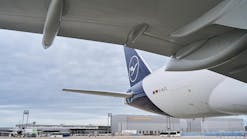High-pressure shutoff valve and pressure-regulating valve position switch
Some operators experience erroneous indications that the high-pressure shutoff valve (HPSOV) has not closed when commanded. These erroneous flight deck and air supply control test unit or built-in test equipment (BITE) module indications result from a shift in the actuation point of the HPSOV/pressure-regulating valve (PRV) position switch Debris and plunger wear, which are caused by the angle at which the actuating lever presses against the plunger bore, which increases the friction between the inner plunger and the switch housing. This friction causes the switch to travel too far (i.e., over-travel) before actuation. Hamilton Sundstrand has improved the wear characteristics and reduced the vibration effects of the HPSOV and PRV position switches by incorporating new material, coating, and design for the plunger and new coating for the plunger bore. Units returned to Hamilton Sundstrand for overhaul since April 15, 2001, have received the redesigned switches. On March 1, 2001, Hamilton Sundstrand issued service information release (SIR) 747BAS141A/767BA032A and incorporated information about the new switches into all its HPSOV-PRV component maintenance manuals. Boeing released service letter 747-SL-36-094 on July 12, 2001, announcing the availability of the redesigned switches. All 767 and 747-400 airplanes with GE or PW engines delivered since July 2001 have these new switches.HPSOV-PRV actuator spring Hamilton Sundstrand also has improved the HPSOV-PRV actuator spring. The service life of the HPSOV-PRV actuator springs varies from 3,000 to 21,000 hours. Spring failures are more prevalent on GE CF6-80C2 engines. The typical failure mode on these engines is spring breakage at the center resulting from high-cycle fatigue. Hamilton Sundstrand has designed a two-piece spring with guide configuration to address this problem. The new spring requires minor machining in the actuator housing. A 0.0025-in. by 0.7-in. machined cut is made on the inside diameter of the housing in the threaded area. The reworked housing can be used with either the single-spring configuration or the new two-piece spring with guide configuration. The new spring will be available from Hamilton Sundstrand in fourth-quarter 2002.Maintenance improvementsComponent overhaul
- Airplane bleed system wiring.
- Sense lines.
- Position and pressure switches.
- Opening and closing pressures of the HPSOV and the high-pressure controller (HPC).
- The PRV and the PRV controller (PRVC).
- The PRSOV.
- The fan-air-modulating valve (FAMV).
The PSHC allows the pneumatic system to be tested on wing. Pneumatic system pressurization is not required, but airplane electrical power is needed.
The PSHC uses a test box that includes plumbing, valves, pressure gauges, hoses, and various fittings to connect to bleed system components on the engines and struts. The built-in monitoring systems on the airplane (e.g., the BITE modules on the 767 and the central maintenance computing system on the 747-400) are used during the PSHC to check discreet system inputs.
Several operators have started routinely using the Boeing PSHC during scheduled maintenance checks. One operator removed six components from eight engines as a result of performing the PSHC; all later were validated in the component shop as failed. Similarly, another operator reported that eight engines were checked using the PSHC, and nine components had indications of failure. The components were removed, and all later were validated in the component shop as failed. These results are consistent with Boeing experience during validation testing of the PSHC procedure for 747-4-- and 767 airplanes during 1999 and 2000.
In addition, since the introduction of the PSHC, operators have reported a significant decrease in the number of pilot reports related to ATA Chapter
36 and improved knowledge of the pneumatic system and component health on the part of engineers and maintenance crews. Operators also have used the PSHC to examine pneumatic components during troubleshooting to isolate failures to individual components.
Boeing videos on the 747-400 and 767 PSHC are available to operators from their Boeing Field Service representatives. Also, a computer-based training CD on pneumatic system component familiarization and the PSHC is available from Hamilton Sundstrand. (Contact Hamilton Sundstrand, Attn: Value-Added Services Training Coordinator, One Hamilton Road, Mail Stop 1-3-BC34, Windsor Locks, Connecticut 06096-1010; fax: 860-654-6906.)
United Airlines PSHCs
United Airlines has developed PSHCs for its fleet of Boeing airplanes, and the checks have been part of its maintenance programs for three years. Although United Airlines maintenance manual procedures for PSHCs differ for each airplane model, the test box and adapters are shared across all models in the United Airlines fleet.
All of the United Airlines PSHC tests can be performed on-wing. The 737, 757, and 767 checks do not require airplane power, but a separate 28v DC power source is needed to energize the controllers. United Airlines established test limits for each component using its component shop manuals
and the vendors' component maintenance manuals. These limits were validated in the United Airlines component shop and on several Boeing airplanes.
Incorporation of PSHCs into an airline's maintenance program
Operators interested in developing and incorporating PSHCs into their
maintenance programs should consider the following steps:
Manufacture or purchase PSHC test boxes and adapters. The Boeing test box and adapters are designed for use on both the 747 and 767. United Airlines test boxes and adapters also are interchangeable among all airplane models in its fleet. Drawings for building the Boeing test box (Boeing part no. G36035-1/-2) are available to operators online through MyBoeingFleet.com in the engineering drawing database (engineering drawing number 0G36035). Operators may fabricate their own test equipment from the drawings or procure the test equipment from a supplier.
Create and validate a PSHC maintenance manual procedure. When possible, Boeing aircraft maintenance manual (AMM) procedures are standardized across airplane models. Several components were tested on wing and in the component shop. The results of these tests, along with Hamilton Sundstrand test limits, were used to validate the AMM procedures. The Boeing PSHC procedure for both the 767 and 747-400 is contained in AMM 36-00-21 for airplanes with GE engines and in AMM 36-00-22 for airplanes with PW engines.
Create training programs to properly accomplish the PSHC. United Airlines conducted maintenance training classes at maintenance bases and key line maintenance stations. The classes included hands-on training
using United Airlines test equipment and AMM procedures.
Record findings for each pneumatic component tested. United Airlines and other operators enter the results from health checks into databases and use that information to predict failures of pneumatic components and to develop and validate minimum build standards for component overhaul shops.
Determine the interval in which a PSHC maintenance program should be accomplished. United Airlines initially checked each pneumatic component during every extensive maintenance check (i.e., 1C). Finding indicated that the check interval for one component could be expanded to every other check (i.e., 2C). Such changes may occur with other components as minimum build standards at component shops are developed and implemented. Operators should evaluate maintenance manual test limits after build standards have been incorporated.
Stock spare components. When first introducing the PSHC, operators should plan for initially higher-than-normal levels of component removal because the failed or failing components will be identified that were previously undiagnosed. For this reason, operators may choose to notify Hamilton Sundstrand or when they plan to implement PSHCs to ensure that
an adequate supply of spare parts will be available.
This article was reprinted from the April 2002 issue of Aero magazine by permission of The Boeing Company. Article by Betsy Hunt, Boeing Commercial Airplanes, Gina Laird-Dion, Hamilton Sundstrand, and John Upchurch, United Airlines.







